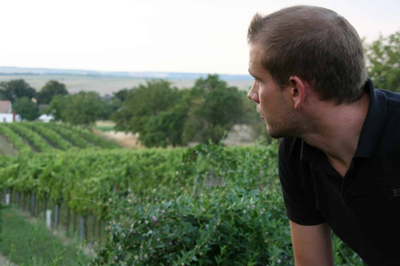Our blog was created to help make the world of wine and beer easier to understand and fun to navigate. There are a million things to know in this industry, we just want to help you understand the latest news and trends from around the globe. So sit back with your favorite sip and let's go on an adventure.
How/Why to Chill Red Wine, Some Info on Our 3-Pack & A Yummy Recipe to Go With Them
Shop our Chillable Reds 3-Pack HERE
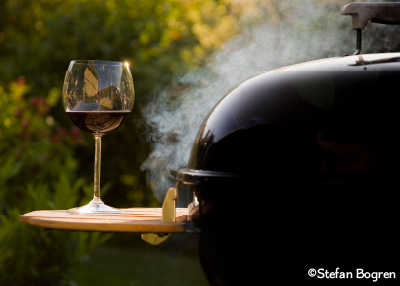
It’s starting to feel like summer. The temperature is going up, the days are getting longer, and the neighborhood streets of Walla Walla all smell like grilling. I love grilling vegetables, but this time of year screams “MEAT” to most folks.
Let’s set the scene. Our recent isolation has given us a lot of time for culinary innovation. “This marinade has 21 different ingredients, 37 steps, and takes 4 days. Perfect.” The day has been hot, into the 90s, so it is still pretty warm when you fire up your grill. You’ve got some steaks, pork chops, whole goose, or bison flanks from your local butcher shop, and you’ve lovingly brined, marinated, dry-rubbed, or sauced them for days on end, until your family members/pets have grown jealous and hungry in equal measures. You flash sear your steaks, or you use indirect heat for your pork, or you cook your bison flanks on a giant Frankenstein grill that you made out of the parts of old broken grills you had sitting in your yard because, COVID DIY. When the time comes, you pull your meat to let it rest (you’re going to let it rest, right? It’s how you show the meat that you’re not an animal, right before you devour it with your bare hands), and you look around for a beverage. A cold beer would be nice, and a frozen margarita would be just fine, but you want something that is going to slake your thirst AND complement the meal that you’ve been working on for the last week. So instead, you reach into the cooler and pull out a chilled bottle of red wine, the perfect pairing for your meaty grill-stravaganza!
What makes a red wine chillable?
Fruitiness, acidity, low tannins, and low new oak. These are wines of refreshment, wines for drinking (vin de soif) rather than pondering or aging (vin de garde). Pinot Noir, Gamay, Austrian reds like Blaufränkisch and Zweigelt, Loire Valley Cabernet Franc, Côt (the local name for Malbec), Grolleau, or Pineau d’Aunis, Frappato from Sicily, Tibouren from Provence, etc. Any light to medium-bodied red will do in a pinch, and almost anything made using carbonic maceration or other less extractive winemaking techniques is perfect.
How cold should I go?
Shoot for 50-55 degrees. Any colder than that and the wines will become muted and inexpressive. I usually do 30 minutes in the fridge or 10-15 minutes in an ice bath. If you overshoot your mark, don’t sweat it. Wine warms up fastest in your glass!
Which wines should I avoid chilling?
Anything heavy, high in alcohol or tannin, or aged with lots of new oak. Chilling makes tannic wine appear more tannic, even metallic. Cabernet Sauvignon (though there are some examples from Saumur, and even Willamette Valley, that would work), Argentinian Malbec and Nebbiolo are examples of wines that show best at a slightly higher temperature.
I slow-cooked some pork on the grill last weekend, and I served it with a lightly chilled Beaujolais-Villages. It turned out great, so I thought I’d pass along the recipe. Remember to keep calm, stay safe, chill down, and grill on.
Pork Brisket with Miso-Marinated Walla Walla Spring Onions
The meat:
- 1.5-2 lb pork brisket
- 1 tablespoon kosher salt
- 1 teaspoon dry mustard
- 1 teaspoon paprika (smoked, picante, whatever)
- ¼ teaspoon cayenne
- ¼ teaspoon ground black pepper
- 2 teaspoon brown sugar
Combine salt and spices. Rub down pork, refrigerate for at least 3 but up to 24 hours.
The onions:
- 6 Walla Walla Sweet Spring Onions
- ¼ cup miso paste (white, red, whatever you’ve got)
- ¼ cup mirin (may substitute ¼ cup white wine with 1 tablespoon of sugar added)
- 2 tablespoons rice vinegar (may substitute apple cider or white wine vinegar)
- 1 tablespoon grated ginger
- 1-2 tablespoon grated garlic
- Couple drops sesame oil
Combine marinade ingredients, whisking until smooth. If the marinade seems thick, thin it out with some water and more mirin/wine. Remove the stems from your onions (these can be used in soups, salads, or as garnish) and quarter lengthwise, maintaining the basal plate by the roots so that the quarters will stay together on the grill. Combine your onions and marinade in a plastic bag or dish. Marinate for at least 3 but as many as 24 hours, occasionally recoating the onions with the marinade.
On the day:
Heat your grill or oven to 250-300 degrees using whatever mastery of fire you prefer (propane, indirect charcoal, electricity, frankenstein bison hibachi, etc). Wrap your brisket tightly in aluminum foil so that no juices can escape (you need the juices later!!!). Grill or roast your brisket at 250-300 for between 2 and 3 hours, until an internal temperature of 200-205. Remove your brisket from the grill, cut a hole in the aluminum foil, and drain out the precious juices. Mix the juices with an equal measure of store-bought sauce, whatever you prefer. This will become the mop sauce for your pork.
While your brisket is resting, grill your onions. Mine took about 10 minutes, but every grill is different. I recommend a bit of color.
When your onions have finished, crank the heat and remove your pork from its aluminum foil. When the grill is up in the 400-500 range, throw the pork back on the grill, along with a thorough basting with your mop sauce. Give it about 5 minutes on this side, saucing occasionally, before very carefully (because it is going to be very tender at this point) flipping it over and basting the heck out of the other side. When it has picked up some color and looks saucy and delicious, pull it off the grill. It is time to eat. Pop a bottle of chilled red wine, grab a hunk of tender pork brisket and some grilled miso onions, and dig in. Also, maybe a salad?
Chillable Reds 3-Pack
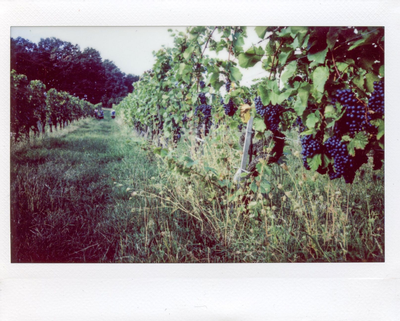
Weninger Blaufränkisch Kirchholz 2015
- Burgenland, Austria on the Hungarian border
- Vines up to 60-years old
- Gravelly clay loam
- Biodynamic viticulture
- 10-day fermentation in concrete
- Aged 20 months in 500l barrels
- Very low sulfur, 0 parts free

Domaine des Chers Saint Amour 2018
- Cru Beaujolais
- 91 points Wine Enthusiast
- 4,000 vines per acre
- Gobelet vines
- Decomposed granite soil
- Handpicked
- 8-9 day carbonic maceration
- 6-month maturation in cement tanks
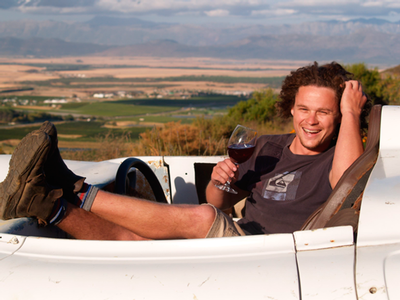
J.H. Meyer Pinot Noir No Sulfur 2017
- Elgin Valley, South Africa
- Johan Meyer, aka “Stompie”, recently named a “Top 10 South African Winemaker to Watch”
- A blend of three vineyards, Palmiet, Elands Rivier and Klein Rivier
- Organic viticulture
- 100% whole cluster ferment
- Zero winemaking additives, including SO2
Get all 3 for just $69 HERE
Learn About our Memorial Day White Wine 6-Pack
Amazing Deal! 6 Wines for Only $75! Shop HERE.
Pratsch, Austria
Pratsch Gruner Veltliner 2018 1L
- 50-acre estate
- Formerly a polyculture farm, began to focus on grape growing in early ‘80s
- Organic viticulture since 1995
- 87 points Wine Enthusiast
- Vegan
-
Apple, apricot, nettle, white pepper
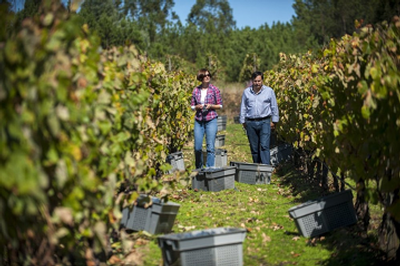
Escolha Azahar, Portugal
Escolha Azahar Vinho Verde 2018
- 60% Loureiro / 40% Pedernã
- Name means “citrus flower” in Arabic
- Fermented and aged in concrete tank
- Organic viticulture
- 89 points, Decanter
- Grapefruit, lavender, lime, salt
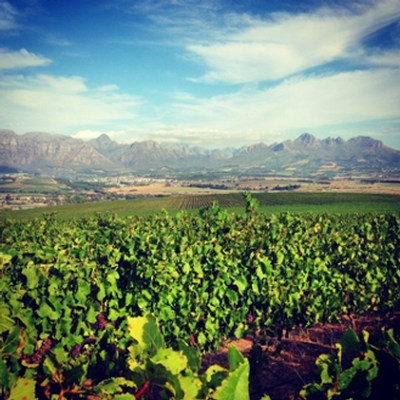
Storm Point, South Africa
Storm Point Chenin Blanc 2018
- Swartland
- Winemaker Mick Craven is one of South Africa’s best young producers
- Sandy, granitic soils
- 20-30 year old bush vines
- 2.5 tons/acre
- Malolactic fermentation blocked to retain freshness in a warm climate
- 10 months in stainless on lees
- Peach skin, elderflower, lemon zest
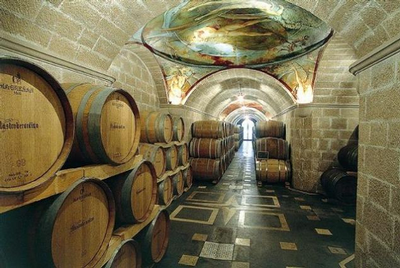
Mastroberardino, Italy
Mastroberardino Mastro Greco Campania 2017
- Greco Campania IGT
- 100% Greco
- Chalk-clay soil
- 3.5 tons/acre
- Fermented in stainless steel
- Tropical fruit, white flowers
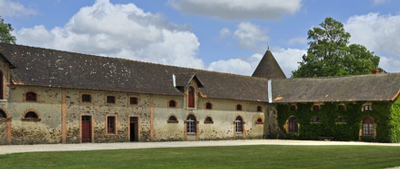
Chateau de la Grange, France
Chateau de la Grange La Berriere Cotes de Grandlieu Muscadet 2017
- Vines up to 60 years old
- 100% Melon B
- Aged 7 months on lees with monthly battonage
- 88 points Wine Enthusiast Best Buy
- Wine and Spirits Best Buy
- Oysters beware!
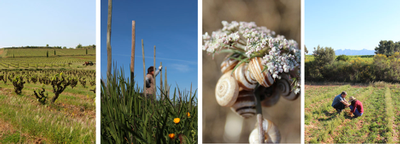
Cellar Credo, Spain
Recaredo & Cellar Credo Miranius Xarel-lo 2014
- Penedes DO
- Unfined, unfiltered
- Biodynamic farming
- 91 points Decanter: “The Xarel-lo and Macabeo blend opens up to aromatic fennel, white peach, and citrus. The palate shows tension and minerality with a purity of white stone fruit and complex mouthfeel Terrific value for an entry-level wine.”
Enjoy this 6-Pack for only $75! Shop HERE
Let’s Talk About Vacqueyras ~ Valley of the Rocks
Shop the Vacqueryas Unicorn Duo HERE

Vacqueyras is situated within the land of heady, alcohol-driven Grenache-based blends – the Southern Rhone - penetrated by intense minerality and fleshy dark fruits offered by the signature stony terroir and the limestone of the Plateau de la Garrigues. Chateauneuf-du-Pape, Gigondas and Vacqueyras are all to be found here – and each express a fierce independence based on their unique and tiny appellations.
Vacqueyras is the baby Cru of the Rhone, the AOC having been established in 1990, after a series of AOC statuses, including Cotes du Rhône(1937) and Cotes du Rhone Villages(1955), as well as its own named Village in 1967. Located to the Northeast of Chateauneuf-du-Pape and just Southwest of Gigondas, Vacqueyras has its own distinct character, producing softer, fleshier wines than neighboring Gigondas. The Grenache here tends to ripen up to two weeks earlier here than in Gigondas and the land is a bit lower and flatter. The wines produced here tend towards a subtlety not found in the higher altitude, more robust Gigondas, and can take on charming, elevated notes of lush stone fruit. The Mediterranean climate here is governed by the famous Mistral winds which aid in keeping the vineyards clear from parasites and fungal disease.
Production in Vacqueyras is governed by strict rules and regulations. Growers are held to a basic yield standard of 36 hectolitres/hectare of vines, thus making Vacqueyras one of the lowest yielding regions in all of France. Additionally, all grapes must be hand sorted and the vines cultivated must be at least three years old prior to their first vintage.
(The town takes its name from the Latin Valléa Quadreria, which means valley of rocks).
Finding Vacqueyras and Sang des Cailloux
A true gem of Vacqueyras, let alone the entire Rhone Valley, Serge Férigoule’s cult-status winery, Sang des Cailloux, produces some of the most poetic wines in the region. This is the wine that I think of as benchmark Vacqueyras. Serge purchased the land of Sang des Cailloux in 1990 after working for the previous owner for 10 years. From that moment on, Serge’s devotion to organic and biodynamic practices altered the vineyards life significantly.
I first discovered Serge’s wines while working in the Portland restaurant scene (in Italian restaurants no less). Arriving nearly 10 years ago to work in the Walla Walla restaurant scene, I found camaraderie and a fierce affinity for Sang des Cailloux wines within the growing winemaker community at the time: this was the wine that young, up-and-coming winemakers came to drink at our bar after late hours in the cellar. And why wouldn’t they be? Serge’s wines are passionate, inky and mineral examples of a Vacqueyras that many have yet to discover and many in Walla Walla aim to emulate. Delve in!

Sang des Cailloux - The Blood of the Pebbles
Serge’s wines are organic, never see stainless steel or fining and filtration. Each of the three reds that he produces are given the Provencal name of one of his daughters (Serge will tell you himself that he is decidedly a Provencal himself, after all – from Avignon)!
The Sang des Cailloux winery is located on the Plateau des Garrigues, a famous limestone mass fabulous for vines, facing the Dentelles de Montmirail between Vacqueyras and Sarrians. Stirred by the Mistral winds, the 17 hectares of the estate are all AOC Vacqueyras.

The Wines
Domaine le Sang des Cailloux Vacqueyras Cuvee de Lopy 2016
80% Grenache, 20% Syrah
Chewable dense purple/blackberry in color. Fierce iron minerality, green olive, garrigue, horse sweat, rich red kirsch and pink peppercorn rising fiercely upwards on the nose along with black fruit. So intriguing! Some stewed black fruit on palate along with black cherry, viscous gumminess on palate. Chewy black licorice, heavily herbal (garrigue), stewed blueberry and blackberry, and tons of graphite. Fatty.
Drink now – 2025
Vacqueyras Rouge Cuvée Lopy:
- Lopy is the name of the farm where Serge Férigoule was born
- Vine age 55 – 65 years
- 4 hectares planted on clay, limestone and scattered galets roulés
- All grapes are harvested by hand
- Grapes are de-stemmed
- Natural fermentation (only using indigenous yeasts) in cement cuves with daily pump-overs
- Parcels are aged separately in 450-L barrels
- Wine is unfined and unfiltered
Domaine le Sang des Cailloux Vacqueyras Un Sang Blanc 2016
20% Clairette, 20% Grenache Blanc, 15% Bourboulenc, 15% Roussanne, 15% Marsanne, 15% Viognier
Super expressive Un Sang Blanc is a pretty rare wine. A blend of 6 grape varietals, this is a wine to be enjoyed young and with rich, opulent dishes. Lovely yellow color. Pop biscuits, butter, diesel, elderflower, yellow flowers and chamomile on the nose. A plump, rich and regal white with excellent tension. Sourced from a 10-year old 1 hectare vineyard.
Drink now.
Vacqueyreas Blanc Un Sang Blanc:
- Vine age 10 years
- 1 hectare planted on clay, limestone and scattered galets roulés
- All grapes harvested by hand
- Wine is vinified in 450-L barrels
- Lees are stirred and the wines completes malolactic fermentation
- Aged for 12 months in 1 – 3 year old barrels
- Wine is unfined and unfiltered
Shop the Vacqueryas Unicorn Duo HERE
Loess is More: The Vineyards of F.X. Pichler
Loess Is More: The Vineyards of F.X. Pichler
Epic F.X. Pichler Duo on sale HERE.
F.X. Pichler is one of the greatest producers of Austrian wine. They have extensive holdings in some of the Wachau’s most prestigious vineyards, vineyards that have been planted for more than 800 years in some cases. These steep, terraced hillside vineyards absorb a ton of sunlight, allowing Pichler to pick Gruner Veltliner, Riesling, and Sauvignon Blanc at maximum ripeness. Wines from the Wachau have a three-tiered system that organizes wines based on finished alcohol levels:
Steinfeder: Named after the wispy grass that grows in the vineyards. These are the lightest wines, topping out at 11.5%
Federspiel: Means “falconry”, these are the mid-weight wines, between 11.5% and 12.5%.
Smaragd: Named after sunbathing lizards, these are the most powerful Wachau wines. Must be over 12.5% alcohol, though many reach into the 14% range.
Lucas Pichler vinifies 70% of his crop as Smaragd every year, harvesting his vineyards in multiple passes. Smaragd wines are phenolically dense and weighty, the vinous opposite of the weightless, crown-capped liter bottles of Gruner that we know and love. The Pichler domaine maintains purity in these monumental wines with a dangerous balancing act. They harvest late, but their brilliant manual vineyard work carefully controls the influence of botrytis, capturing a dusting of ginger and pollen without collapsing into heaviness or rot. This viticultural balancing act is akin to walking a tightrope with an unruly toddler on your back. In the cellar, Lucas allows fermentation to progress until the wines are (functionally) dry, but arrests it before they begin malolactic fermentation, further preserving freshness and vivacity.
These Man on Wire wines are made possible by the incredible vineyards of the Wachau. Here are three of F.X. Pichler’s best.
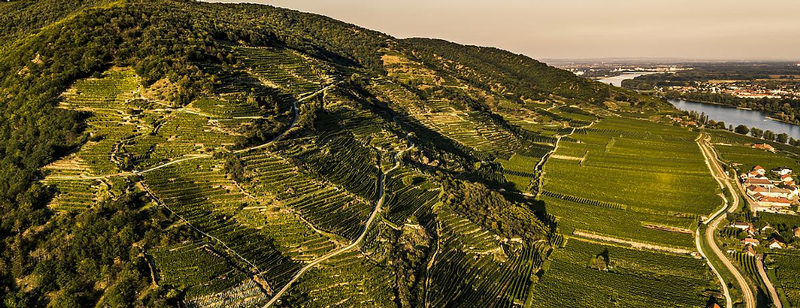
Loibenberg
Loibenberg is large, at 76 acres, and warm, though its assorted aspects and pitches make it more climatically varied than many single vineyards. The first mention of Loibenberg dates back to 1371, and it has been cultivated ever since. This vertiginous slope averages a 40% incline, though some pitches can be as steep as 80%. These terraces require 300 man-hours bruising, fatiguing labor per acre. The soil consists of a thin layer of glacial loess over decomposed gneiss. Yes, the same loess that makes up most of the soils in the Walla Walla Valley. The vineyards of the Wachau are defined by their proportion of loess to gneiss. The thicker, more generous loess soils are ideal for Gruner Veltliner, whereas the rockier soils where the gneiss substrate is closer to the surface favors Riesling. This rocky, sandy ground provides excellent drainage, whisking away water so the vines can continue to hang their crop late into the season without risking rot. F.X. Pichler sources most of the grapes for their “M” (for “monumental”) cuvee from this historic vineyard.
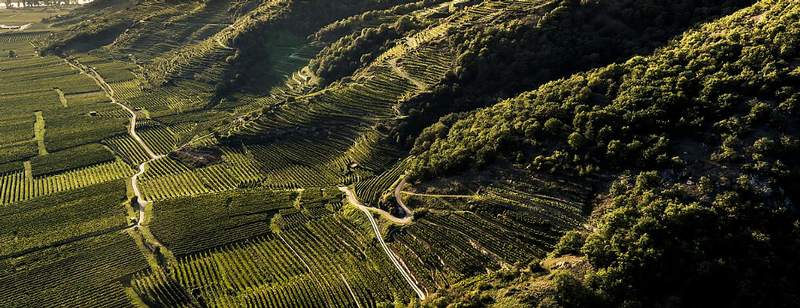
Steinertal
Steinertal means “stony trench”, an appropriate name for this curving, amphitheatre-like vineyard on the eastern end of the Wachau. It is one of the coolest vineyards in the Wachau, as well as one of the rockiest. Here again you will find thin sandy loess over gneiss, though the gneiss is especially decomposed in Steinertal, allowing the roots of 70 year old Gruner Veltliner to burrow deeply into the bedrock. Pichler’s Steinertal Gruner has all of the Smaragd power that characterizes their bottlings, but the cooler climate finesse of the site shines through in its graceful midpalate and refreshing finish.
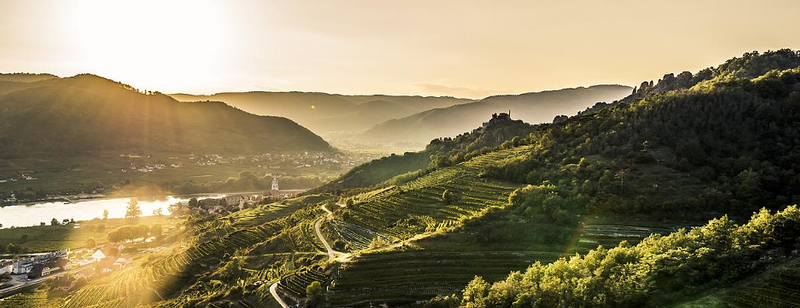
Kellerberg
Kellerberg, or “cellar mountain”, falls somewhere between Loibenberg and Steinertal in warmth. It faces the south and southeast, and its finest aspects look directly out over the Danube. The south eastern exposure has limited erosion from wind, preserving more loess in the soils. The lower slopes have more humus and loam, and as you climb you find more stones. F.X. Pichler sources their Kellerberg Riesling from a parcel high up on the hill, where the soils are thin and less vigorous. The struggling vines produce fruit with great intensity and savor, and the wines are exceptionally long lived. Expect your Pichler Rieslings to keep for at least 20 years.
The Wachau has some of the finest white wine vineyards in the world, and F.X. Pichler has many of the finest parcels within the Wachau. So, take a cue from the wines of the Wachau and sunbathe like a lizard while you savor an F.X. Pichler Gruner Veltliner or Riesling.

Shop HERE for Epic F.X. Pichler Duo
ADD 'M' Monumental Smaragd Gruner Veltliner 2016
Adventures with Trousseau
Trio of Trousseau

Eyrie Vineyards, Willamette Valley
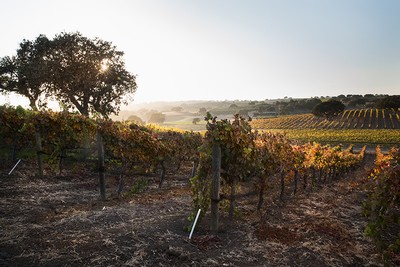
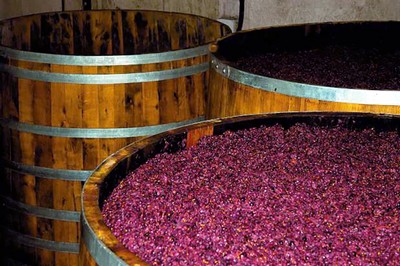
Stolpman Vineyards, Santa Barbara Domaine Tissot, Jura, France
Trousseau is somewhat of a mystery to many wine drinkers. Indigenous to the Jura region of France, in the town of Montigny-les-Arsures, the dark-skinned grape varietal has quite the history in Europe and is known to have been cultivated for at least 200 years under a variety of names. Curiously, until recently it has most widely been known in Portugal as Bastardo where it is made into dry red table wines as well as their most famous exports, Porto and Madeira. In Spain, it can be found under other names, Merenzao and Verdejo Negro, where it is used both alone and in red blends.
The most compelling Trousseau are those that can be coaxed into a subtle and balanced expression of tart red fruit, minerality and mossy earth. Trousseau can easily become a high-octane wine, due to the naturally abundant sugars in the grape varietal. Due to this, it can be considered fully ripe and ready to pick when at a lower sugar level than other varietals, thus producing a wine that is higher in acid with less alcohol.
I first discovered Trousseau while “palate trouncing” through the wines of the Jura in my first years in the restaurant world. I was instantly taken by these unusual and rustic wines, at times confused by their strangeness and curious as to what made them so much different than the polished New and Old World wines to which I’d become so accustomed. The initial rawness and brutality impressed but intimidated me. I was confused but not put off. As I began to dig deeper into the world of Jura wine, I discovered there existed a subtlety and odd grace to these wines that I had never had the opportunity of tasting. Odd grace – like an elephant on ice skates.
Let’s not beat around the bush: I have fallen for Trousseau. I am drawn to varietals with strange minerality and evocative dark forest matter, bright and light fruit piercing through the undergrowth to create a truly compelling wine. It can take on notes of light and bright sour cherries, ripe red fruit and expiring green matter or, depending on vinification technique, become a pungent, alcohol-driven, red fruit beast in need of a good chill. It is the forgotten street poet of grapes – full of nuance, easily irritable (thus “Bastardo”), and waiting for recognition of its subtle, easily-overlooked beauty.
New World winemakers are clearly catching on to the appeal of the varietal and Trousseau plantings are popping up with established producers’ names attached throughout the West Coast of the U.S., notably in regions where Pinot Noir, Gamay and other Burgundian varietals have shown success.
In this trio of wines, I have chosen to include Trousseau from its ancient birthplace – the Jura – as well as two of its more recent homes, California and Oregon. By highlighting an essential Jura producer alongside two groundbreaking New World producers, I hope to open a window and offer us a glimpse into the future growth and style flexibility of Trousseau in the modern wine world as we know it. Here is a remarkably unusual chance to explore this oft-forgotten varietal through the artistry of some truly inspired winemakers of our present time. I hope you love them as much as I do.
For the wine drinker who appreciates Pinot Noir and Gamay, these wines should easily appeal. This is food wine: gracefully footed with delightful acid and bright, pungent fruit expression, offering excellent pairing opportunities. These may all be considered natural, organic wines.
Pair Trousseau with: Game birds, smoked pork, berry reduction sauces, paté, or hard cow’s milk cheese (Morbier, e.g.).
“Bring in the bottled lightning, a clean tumbler, and a corkscrew.” - Dickens
Cheers,
Emily Riley
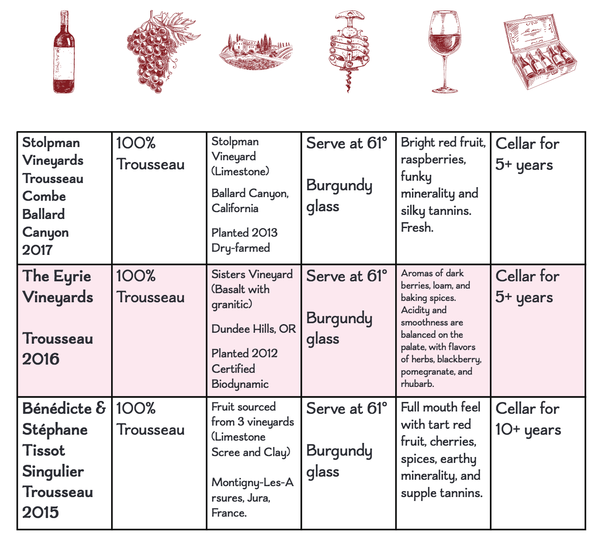
Trio of Trousseau
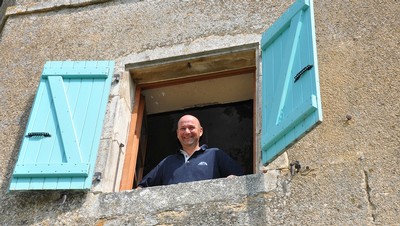
2015 Trousseau ‘Singulier’
Bénédicte & Stéphane Tissot
Bénédicte & Stéphane Tissot produce some of the most intriguing and delightfully mysterious wines of the Jura (Arbois) region in France on their 100 acres of vineyards. Biodynamically certified with Ecocert and Demeter, the Domaine takes painstaking measures to grow, harvest and vinify their grapes in a manner that reflects the utmost respect for their home.
The Trousseau for the ‘Singulier’ is sourced from 3 famous South and East-facing vineyard sites planted on limestone/clay soils. The age of the vines dates back to 1930. Grapes are manually harvested and bottled without fining or filtration. These are incredibly pure, low-intervention wines with a laser-sharp focus on the Jura’s unique terroir and their artful expression of it.
The Trousseau ‘Singulier’, brownish-garnet in color, reminds us of aged Nebbiolo at first sight. With a nose of wild red berry, crushed granite, old charred wood, mossy wet earth, damp green herb, and freshly foraged mushrooms, this is a wine that permeates the senses. On the palate one finds bright and tart red fruit – cranberries and raspberries – with a structured tannic backbone and an earthy, fresh minerality. Finishes with black licorice and molasses on the back palate.
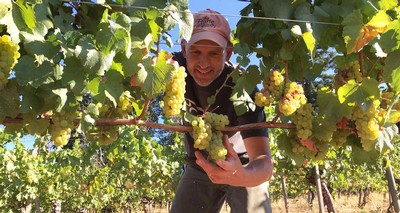
2016 Trousseau
Eyrie Vineyards
Eyrie Vineyards is a special winery. David Lett (1939 – 2008), the founder of Eyrie, was the first to plant, cultivate and vinify both Pinot Noir and Pinot Gris in Oregon, winning them multiple accolades over the years. His son, Jason Lett, took over as winemaker in 2005 and proceeded to plant additional varietals and introduce wild yeast fermentations to Eyrie’s winemaking philosophy. Eyrie Vineyards is certified organic/biodynamic.
Inspired by the winemaking and varietals of France’s Jura region, Eyrie Vineyards planted the Willamette Valley’s first Trousseau vines in 2012. The vividly red wine has aromas of dark berries, loam, and baking spices. Blackberries and brambles, along with tart red fruit on the nose. Stemmy undergrowth. Superbly unctuous on the palate - bright raspberry and rhubarb – with a beautiful mouthfeel, lightweight tannins, and perfectly balanced acidity. Worthy of laying down in the cellar. 2016 is the second vintage of this intriguing wine.
6 months in neutral French oak, full indigenous malolactic.

2017 Combe Trousseau
Stolpman Vineyards
“Combe” refers to a sheltered valley within a vineyard. In his collaboration with Pete Stolpman of Stolpman Vineyards, famed sommelier Rajat Parr has created a truly unique and enjoyable wine with Combe Trousseau. Having convinced Stolpman Vineyards to plant Trousseau in Ballard Canyon,
California, Rajat Parr helped to create a wine that is expressive of both terroir and the Master Somm’s well-respected sensibilities.
Stolpman Vineyards has 153-acres of vineyard land in the Santa Barbara County AVA, planted along limestone ridges that are meticulously dry-farmed.
This is the 4th vintage of Combe Trousseau, incorporating two separately planted vineyard blocks, the second having been planted in 2014. The 2017 Combe Trousseau was picked early – at the end of August – and thus spared the September heat spike that the Canyon experienced. Accentuated by its time spent in concrete fermenters, the wine shows freshness, bright red fruit quality, funk, and a lively minerality.
70% destemmed, 30% whole cluster. Aged in neutral French 500L Puncheons.
Northern Rhône
Roasted Slopes, Burnt Earth, and BBQ
Shop the Battle Rhône: North vs. South 4-Pack -- bottles detailed below
Syrah has rapidly established itself as a signature varietal in Walla Walla, recently supplanting Merlot as the second most planted variety in the AVA. The best Walla Walla Syrahs exhibit a feral, savory edge that reminds me of wines from Syrah’s birthplace in the Northern Rhone valley. While many people are familiar with Rhône blends, the classic Grenache-Syrah-Mourvédre-etc. combination is styled after traditional Southern Rhône blends from Mediterranean appellations like Gigondas or Châteauneuf-du-Pape. The Southern Rhône produces 95% of all Rhône wine, so finding good examples of northern Rhône wines can be challenging. Luckily, the shop is always stocked to the gills with archetypal examples of Côte Rôtie, Hermitage, and Cornas, as well as everyday drinkers from Crozes-Hermitage, Saint Joseph, and the broad Collines Rhodaniennes designation.
Northern Rhône Syrah is my desert island, death row final meal, death bed wine. I’ve been reading the 700 page “The Wines of the Northern Rhône” by John Livingstone-Learmouth for fun. So, indulge me if you will, while I rant about French fruit into the consensual hallucination we call the interwebs.
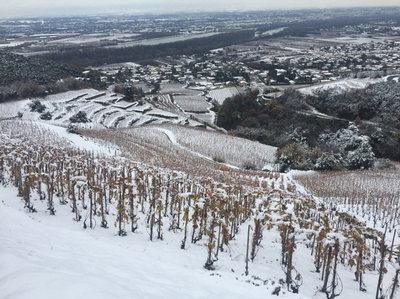
Jean Luc Colombo, Cornas
Weather
As I mentioned above, when we picture the Rhône, we generally think of the south of France. Warm Mediterranean winds, maybe an olive tree or two, scrubby garrigue wafting scents of thyme and rosemary as vigneron pick bunches of Grenache off of gobelet-trained bush vines: the kind of place a medieval Pope would go on vacation.
The Northern Rhône is a different animal (probably a furry one). It is continental, with cold winters and warm, but not hot, summers. “But wait,” the few francophones among you say, “doesn’t Côte Rôtie translate to “roasted slopes”?” “Yeah,” the even fewer celtophones among you say, thrilled that their college minor is finally paying off (take that, Dad!), “Cornas means “burnt earth” in old Celtic!” That’s true, but it’s an example of the difference between a warm climate vs a warm spot in an otherwise cool climate. Failla winemaker Ehren Jordan worked several years for Jean-Luc Columbo in Cornas, and he recalled arriving on a warm (by no means hot) 80-degree summer day to find the locals complaining about a heatwave. Côte Rôtie is closer to the Beaujolais than Avignon, and it represents the northernmost plantings of Syrah in France.
The relatively cool weather draws out a unique expression of Syrah. The delicate violet and spicy aromas that typify cool-climate Syrah burn off in high heat,1 giving way to black plum, chocolate, and coffee. You see this difference within the Northern Rhône itself. Côte Rôtie in the north is generally the lightest and most ethereal of the appellations, more red-fruited driven than the warmer vineyards of Hermitage and Cornas, which produce a rich, more robust wine with darker fruit.
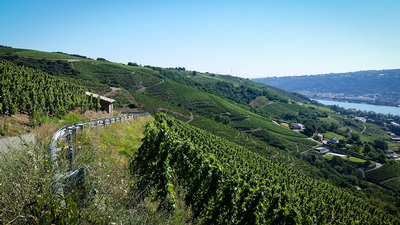
La Grande Colline, Cornas
Vineyards
Syrah is the only red grape allowed in wines of the Northern Rhône, though Viognier is allowed for co-fermenting in Côte Rôtie, and Marsanne and Roussanne serve the same role in Hermitage. The best vineyards are on very steep south-facing hills that allow greater heat accumulation and ripeness. The vines are traditionally trained up a stake in a style called “echalas”, much like the Mosel or Mt. Etna. These stakes allow the Syrah shoots maximum sun exposure, while allowing vineyard workers useful climbing aids while they work in the vineyards. Planting is high density, from 3-4k plants per acre, and the work required is enormous. Mechanization of the steepest, grandest slopes is impossible, and one vigneron estimated that it took 400 man-hours per acre to care for the vines. Some of the wealthiest landowners hire helicopters to spray sulphur and other vineyard treatments. Yields are low (often less than 2 tons per acre), and given the backbreaking work required, it is no mystery why many vineyards were abandoned in the lean years between phylloxera and the gradually increasing prices of the 1980s and 90s.
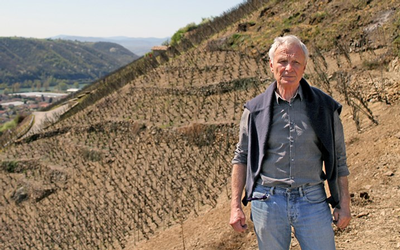
Rene Rostaing, Côte Rôtie
Winemaking - To Stem or Not To Stem
“One aspect here, admittedly less severe than at St. Joseph, is that of young growers coming on stream and turning out technobabble wines. The previous generation was involved with what to plant, following decrees, mastering white wine vinification, tidying up their cellar work. This current generation is feeding off a high price regime and lending their ears to advisers and image dabblers, the theory merchants who dispense advice without responsibility. Suddenly a father-to-son Domaine switches from the serenade to punk rock: a world of injected oxygen, lees stirring, high-temperature fermentation, max extract, and wines that fall apart after just 20 minutes of air.” John Livingstone-Learmouth, on Crozes-Hermitage.
As with Barolo, the Northern Rhône has had a stylistic divide between traditionalists and modernists. Traditional vinifications were done whole cluster, with the fruit crushed by foot and fermented in concrete tanks, before aging in concrete, foudre, or old 600l demi-muid barrels. Modern techniques rely on destemming, extended macerations, new 225l oak barrels, and a range of enological products. More recently, a middle way has formed, utilizing both modern and traditional approaches. The traditional wines have gained purity from softer tannins and more rigorous barrel selection, and the modern wines show less new oak and dry extract.
The choice of whether to destem or not remains crucial. Classic producers like Clape in Cornas or Jamet in Côte Rôtie continue to utilize 100% (or nearly) whole cluster, while Lionel Faury in Saint Joseph is less prescriptive, incorporating various levels of whole cluster depending on the cuvee and vintage. Even Guigal, as modern a producer as they come, uses large amounts of whole cluster in ripe vintages. Whole cluster fermentation brings sappy, floral spice to a wine, emphasizing the lighter and more delicate elements of cool-climate Syrah. Some vintners like Thierry Allemand, Jean Michel Stephan, and Herve Souhaut utilize carbonic maceration, leaving their whole bunches uncrushed. This produces a silky mouthfeel and explosive fruitiness that, when combined with Syrah’s more animalistic side, creates a very complete expression of the grape.
The Wines
I recently described wines from the Rocks District as “a bear in a blanket, waiting for Goldilocks”. Syrahs from the Northern Rhône, their stylistic parents, are a bear in a meadow. Sure, they could tear your face off, but they’d rather eat blackberries and play with wildflowers. They can be feral and smoky, like wild boar bacon with freshly cracked black pepper and mixed olive tapenade. All of this ursine ferocity is wedded to pure violet and bramble, with huckleberry and blackberry running down your chin. The monumental structure of bristly whole cluster traditionalists holds up well to cellaring, as do densely extracted modernist wines, with good examples showing well after 10-15 years. Young wines, especially from more affordable appellations like Saint Joseph and Crozes-Hermitage, drink very well in the meantime, with snappy red or blue fruit amidst tufts of savor. I love these wines with anything from the grill. Lamb and beef are classic pairings, especially for the darker wines of Cornas or Hermitage. The lighter wines pair well with hearty pork, dark meat chicken, or game birds. Who could say no to some medium-rare grilled duck breasts and a glass of Côte Rôtie?
[1] Rotundone accumulation, the black pepper aroma, is directly related to temperature in the fruit zone.
Battle Rhône: North vs. South 4-Pack
North:
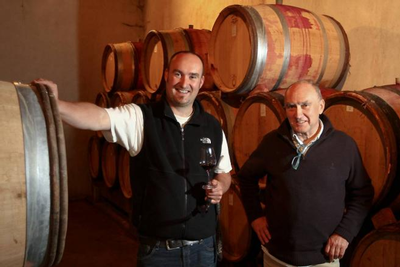

Maxime and Alain Graillot, Domaine Equis
Equis Equinoxe Crozes Hermitage
- 100% Syrah
- Practicing organic
- commune of Beaumont Monteux
- Native yeast ferment in concrete tank and large wooden tronconique vats
- 80% destemmed
- Aged in used DRC barrels for 9 months
- 3,300 cases
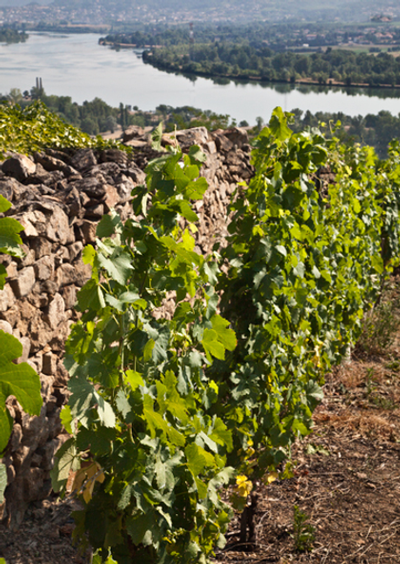
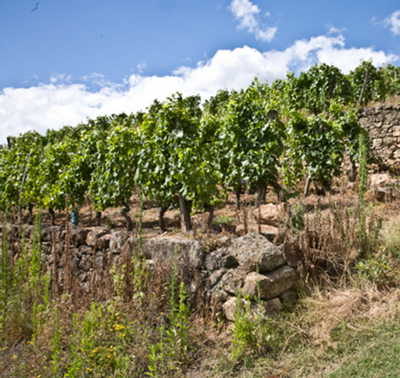

Domaine Faury
Faury Collines Rhodaniennes Syrah
- Granite soil
- Partially destemmed
- 10 day maceration
- Aged 6 months in 600l demi-muids
South:
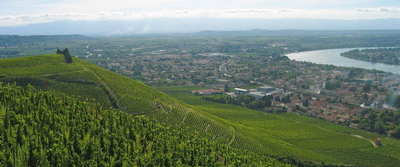

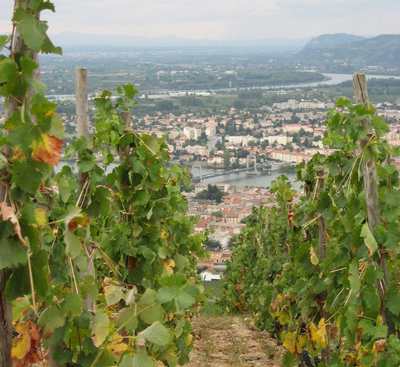
Delas Freres Vineyard in Hermitage
Delas Cotes du Rhône St. Esprit 2017
- 60% Syrah/40% Grenache, grown in the Ardeche
- 88 Points WS
- 41k cases
- All destemmed, 15-day maceration, aged in stainless for 8 months
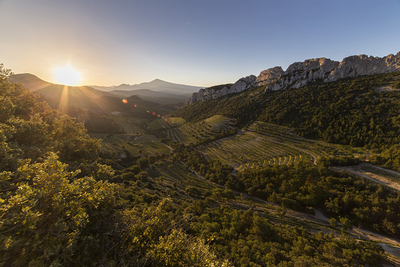

Gigondas
Domaine du Cayron Gigondas
- Low yields 30hl/ha (less than 2 tons per acre)
- 40-70-year-old vines
- 78% Grenache, 14% Syrah, 6% Cinsault, 2% Mourvèdre
- 21-day maceration
- Aged in foudre for 12 months
- Unfined, unfiltered
Walla Walla's New Wave...Something Wicked This Way Comes
WALLA WALLA NEW WAVE 3-PACK - $78
(Click above to shop)
We can’t help ourselves – we love wine notes - and we are going to give them to you for this wicked little 3-pack. Roald Dahl would likely be encouraging of our little homage and pop open a bottle alongside us if he could. So, let’s see…Cab, Merlot, Chardonnay, Cab, Merlot, Chardonnay, Cab, Merlot, Chardonnay... Wait, what have we here? A white wine made from red grapes, a (light) red from grapes that usually make white wine, and a delicious, baby-faced Cabernet Franc that was born in a jar.
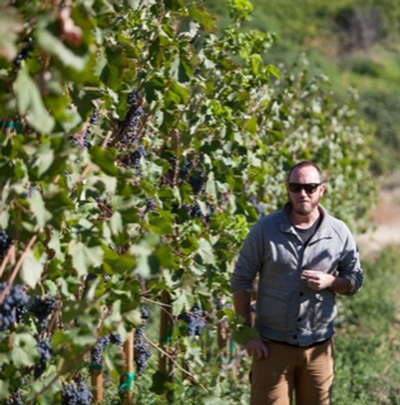
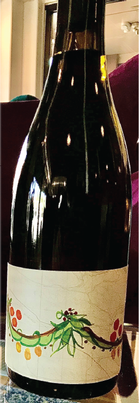
Keith Johnson of Devium
2019 Devium Solaksen Vineyard White Pinot Noir
- Solaksen Vineyard - Royal Slope AVA
- Native yeast ferment
- Previous vintage sold out in 1 week!
We’ve enjoyed Keith Johnson’s Devium wines since his inaugural 2015 vintage, from his crisp Marsanne to his flagship French Creek Vineyard red blend. The inspiration for this rare still blanc de noir came during a night of wine and revelry with a winemaking friend. Keith sources Pinot Noir from Solaksen Vineyard in the soon-to-be Royal Slope AVA, pressing the clusters immediately to eliminate skin contact. The resulting wine has all of Pinot Noir’s depth with (almost) none of the color.
You'll love Keith's other wines too (click each to shop):
- Devium French Creek Vineyard Marsanne 2016
- Devium French Creek Vineyard Mourvedre Sans Soufre 2018
- Devium French Creek Vineyard Red 2017
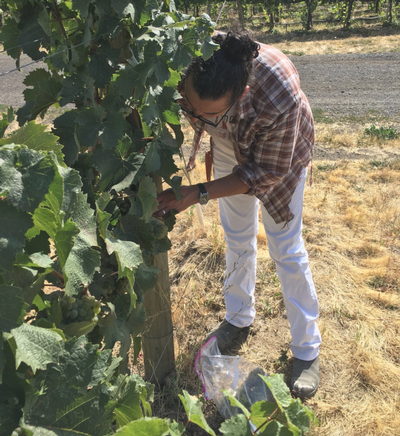

Robert Gomez of Hoquetus Wines
2019 Hoquetus Wines Cabernet Franc, Blue Mountain Vineyard
- Blue Mountain Vineyard in the eastern foothills of the Walla Walla AVA
- Native yeast ferment using pied de cuve
- Aged in amphora for 4 months
- Unfined, Unfiltered
- 69 cases
Hoquetus Wines is a brand-new project from Advanced Sommelier Robert Gomez. This crushable Cabernet Franc started its life in Blue Mountain Vineyard before settling down with its own native yeasts in a ceramic amphora shipped directly from Italy. Robert bottled it early, preserving freshness and immediacy. This bouncy local red is for fans of the Loire, Beaujolais, or Auvergne. Expect raspberry, crab apple, and rose hips.
You'll love Robert's other wines too (click each to shop):

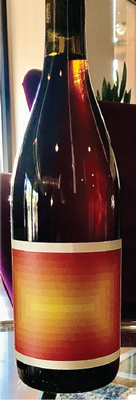
Tim Doyle in the vineyard
2018 Marginalia Light Red Wine
- 67% Pinot Gris, 33% Pinot Noir
- Breezy Slope Vineyard in the southeastern foothills of the Walla Walla AVA
- Whole cluster ferment
- 6 days skin contact
- Unfined, Unfiltered
Marginalia’s Light Red took the shop by storm last year with its brilliant ruby color, equally bright orange label, and profound drinkability. Winemaker Tim Doyle’s category-less blend of Pinots Gris and Noir comes from Breezy Slope Vineyard, one of the highest elevation sites in Washington state. Think Rose de Riceys or Coteaux Champenois, but with Walla Walla’s sunshine. It takes a chill well, and Tim recommends serving between 45-55 F. It looks (and tastes) great with a summer sunset.
You'll love Tim's other wines too (click to shop):
“If you have good thoughts they will shine out of your face like sunbeams and you will always look lovely” – Roald Dahl
Tiny Bubbles...The World of Sparkling Wine

A well-riddled bottle in the cellars of Gaston Chiquet, from Skurnik
One of the hardest things about working in the wine industry is that you wind up with a taste for Champagne, even if you’re on more of a “Champagne of beers” budget. The economics of Champagne1 means that it can be difficult to drink it as often as we’d like. Despair not, though, because delicious sparkling wines2 are made the world over. Saber open a bottle of local pet-nat with your trusty cavalry sword, pour yourself a bubble bath, and dive in. It’s time to talk fizz!
Traditional - France
For many folks, sparkling wine is Champagne, so let’s start there. Champagne lies very far north in France, just to the east of Paris near the city of Reims. It has a very cool, rainy climate, so even though the Champenoise grow grapes that ripen early (Chardonnay, Pinot Noir, Pinot Meunier3), in many vintages they struggle to achieve sufficient ripeness to produce still wines. These grapes, because of their high acidity and low potential alcohols, are perfect for sparkling wine.
The process for making Champagne is known as the traditional method (methode traditionnelle). First, the grapes are picked and pressed, just like regular white wine. The juice is then fermented, usually in stainless steel tanks or oak barrels depending on the winemaker’s4 preference. The highly acidic still wines that are produced are called the vin clairs.5 These are blended with reserve wine from previous vintages (unless the producer wants to make a single vintage wine) before being bottled with a small amount of yeast and sugar. As the yeast ferments the sugar, it produces carbon dioxide. This trapped CO2 from the second fermentation stays in the bottles…And Blammo! - we’ve got bubbles.
As the yeasts die, they drop out of the wine and form sediment in the bottle known as lees. The amount of time a sparkling wine spends on the lees has a huge impact on its aroma and flavor, contributing notes of baking bread or roasted nuts which round out and soften the wine. A non-vintage Champagne must spend at least 15 months on its lees.
After the lees are removed through a process known as disgorgement6, the wine is dry and still very tart, so a small amount of sugar is added to balance the wine. This is the dosage, and it determines the finished sweetness of the Champagne. Brut is the most common level (~12g sugar), but drier styles have become more popular recently, with some producers choosing to forgo this step altogether in favor of Brut Nature or zero dosage wines.
Sparkling wines from other regions of France that are made in the traditional method are known as Cremant. These are some of the best deals in sparkling wine, checking most of the stylistic boxes of Champagne without the steep price tag. Alsace has a particularly rich history of sparkling wine production,7 and their Cremants are simply delicious. Check out the Cremants d’Alsace from our shop favorites Kuentz-Bas or Pierre Sparr.
Traditional - Spain, Italy, England8
There are many classic examples of traditional method sparkling wine made across the world. In Spain, the Catalonian varieties Xarel-lo, Macabeau, and Parellada are used to make rich, zesty Cava, many of which can be found for less than $20. We’re currently featuring the CVNE Brut for $13 and the Mas Fi Brut for $12. Spain is often the place to go for wine bargains, but their sparklers take this to another level.
Italy and England produce some of the classiest bubbles outside of Champagne. The sparkling wine producers of England are blessed with the same chalky limestone soils and cool climate as Champagne,9 producing wines of similar pedigree. Try a bottle of Digby Fine English Leander Pink Brut NV the next time you’re in the mood for some fancy pink bubbles. For an Italian take, the DOCG of Franciacorta in Lombardy is home to Chardonnay, Pinot Noir, and Pinot Blanc that sees a traditional secondary fermentation in bottle and extensive lees aging. Sound familiar?
Non-Traditional - Italy
From “is it actually sparkling wine or did I just shake it?”, Frizzante to vigorously frothy Spumante, Italy has got it all. Prosecco, the most famous Italian fizz, is made using the Charmat Method, which is kind of like traditional method on a larger scale. Here, the secondary fermentation takes place in a pressurized tank rather than in each bottle, streamlining the process and allowing Prosecco producers to charge less for their delicious wine. Look for Prosecco Superiore DOCG and leave the orange juice in the fridge.
While I love Prosecco before dinner as an aperitif, Lambrusco really shines on the table. This frizzante from Emilia Romagna or Lombardy can range from bone dry to slightly sweet10 and from dark pink to almost black. We love Lambrusco for its pitted cherry and wild strawberry aromas balanced by savory spice and lovely acidity. Pair the shop favorite Cleto Chiarli Vecchia Modena Premium Lambrusco di Sorbara 2018 with a large cheese and charcuterie plate and you might just forget to serve the main course. Don’t forget to pour a pearly glass of Moscato d’Asti from a conscientious producer like De Forville for dessert.
[1] Difficult farming in a marginal climate, a labor-intensive vinification process, expensive packaging, and long cellaring requirements before release (3 years for vintage champagne, though many houses go much longer).
[2] Just don’t call them Champagne if they’re not from Champagne. The Champenoise have been fighting that particular fight since at least 1891.
[3] There are select growers like Laherte Freres with plots of Pinot Blanc, Pinot Gris, Arbane, and Petit Meslier, but Champagne is most often the big three mentioned above.
[4] Known in Champagne as the “chef de cave”, which is kind of how I’ve felt during social distancing.
[5] The tasting/blending of which is supposed to be a palate-crushing experience
[6] Which can be very, very messy if you don’t know what you’re doing.
[7] They produce more than half of all Cremants.
[8] South Africa also makes delicious traditional method wines under the name “cap classique”
[9] There’s a famous channel between them, but Champagne is darn close to Sussex
[10] Many people think that Lambrusco is always sweet, but that is mostly down to a few industrial producers making crappy wines
About the wines in this offer…
La Vielle Ferme Reserve Brut
The Perrin family of Chateau Beaucastel harvest Chardonnay and Ugni Blanc from limestone soils that preserve natural acidity, then perform regular batonnage to add savory richness. Apples, oranges, and lemons abound, like a still life painting in a glass. This dry, toasty French bubbly is best when deciding which of your family members you trust to cut your hair (answer: you love them all, but absolutely none of them).
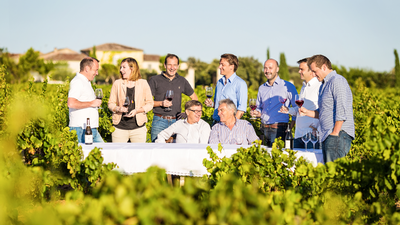
Perrin family
Acinum Prosecco
These Glera vines are trained in a Veronese pergola, which is pretty much a lawn chair for vines. The winemakers took their time, harvesting the grapes by hand, gently pressing, and slowly fermenting the wine with native yeasts. Take a leisurely tip from the pergola and enjoy the soft, inviting nose of honeysuckle and candied citrus palate in a backyard kiddie-pool folding chair.
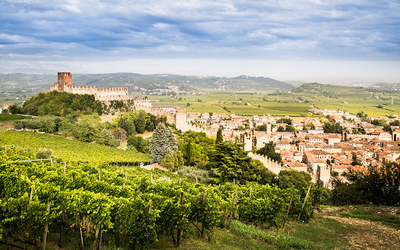
Acinum’s vines in the Prosecco area of Treviso
Domaine Xavier & Agnès Amirault Les Quarterons Cremant de Loire Brut
Chenin Blanc’s natural acidity makes it perfect for sparkling wines. The fruit for this traditional method sparkler comes from Anjou, and it ages at least 18 months on fine lees, gaining weight and complexity. White grapefruit and a streak of chalky minerality make this refreshing Cremant the ideal accompaniment for breakfast (or brunch, or breakfast for dinner) in bed.
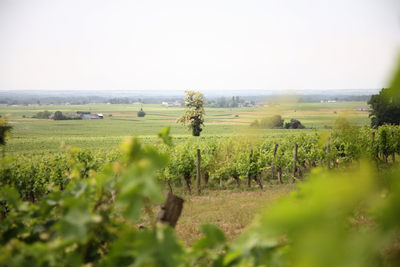
Les Clos de Quarterons
Juve Y Camps Reserva de la Familia Gran Reserva Brut Nature 2016
This blend of 40% Xarel-lo, 30% Macabeo, 20% Parellada, and 10% Chardonnay spends 36 months aging sur lie. Aromas of stone fruit and baked bread combine like a peach cobbler, though the ripping Brut Nature finish is long and totally dry. Drink this vintage cava while watching YouTube videos about sourdough starters.
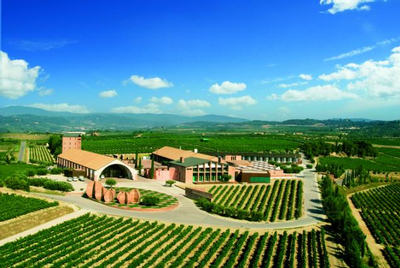
Juve Y Camps
Click to Shop!
Etna...Taste the Volcano
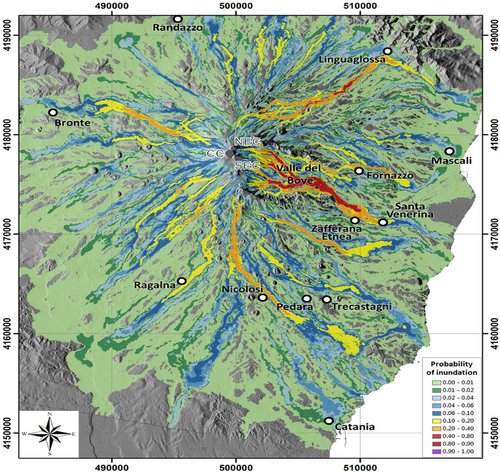
Map of Mt. Etna
Taste the Volcano
The next time you hear a local vineyard manager complaining about mildew pressure, drought, or frost, remind them that the vineyards of Mount Etna in Sicily face those same challenges, as well as the constant threat of burning ash and MOLTEN LAVA! Some years, the mountain is quiet. Other years, as in 1981, houses and vineyards are destroyed. Most terroir, from the Jurassic limestones of the, uh, Jura, to the fractured basalt of Eastern Washington, has been in place for millions of years. Etna, on the other hand, is continually remaking itself, adding layers of ash and rock with each new eruption. After each discharge, vignerons scramble to plant on the new surface. These are vineyards forged from fire and ash.
The vines of Mt. Doom, I mean Etna, cling to the side of the active volcano at elevations as high as 4,300 feet, making them some of the highest commercial vineyards in the world.1 Traditional vineyards are planted “albarello” style (little tree), meaning each vine is trained up a post.2 These old vineyards are often densely planted polycultures with olive trees, fruit trees, and other crops scattered among vines that can be as much as 240 years old. Phylloxera seems to avoid black volcanic soil,3 and the oldest vineyards remain ungrafted. Etna has produced wine since Roman times, but most of its vineyards sat abandoned until its resurgence of the last 30 years. The Benanti family founded their winery in 1988, marking the first modern investment in the region.
Etna is home to many indigenous varieties, but there are really only a couple that you need to remember. The reds are made from Nerello Mascalese (sometimes with a little Nerello Cappuccio or Alicante Bouschet thrown in for color), while the whites are typically Carricante based. Nerello Mascalese is a late ripener, often hanging well into November. Its wines are perfumed and earthy with a waft of volcanic ash, recalling blood oranges, and lapsang souchong tea. They are often compared to Nebbiolo or Pinot Noir, wines that show sous bois (undergrowth or forest floor) aromas. If good red Burgundy smells like walking through a damp forest, then Etna Rosso smells like walking through that forest a year after a fire.
Carricante, like its translucent red counterpart, couldn’t hide its volcanic origins if it tried. This neutral, savory white often grows on the eastern side of Etna in vineyards where Nerello Mascalese would struggle to ripen. The Etna Bianco DOC requires that a wine be at least 60% Carricante, and Superiore wines must be 80%. It’s a high acid grape, presenting citrus fruits of lemon or orange, but we’re here for the rocks. The best examples scream volcano with pyroclastic minerality4 like a sprinkling of smoked sea salt, which stretches the finish and leaves you looking forward to your next sip. Carricante means “loaded”, and it must be short pruned to tame its tendency to overbear. With careful viticulture, Carricante can produce profound wines that rival Italian classics like Soave, Fiano, and Verdicchio in ageability and intensity, cellaring for 10 years or more. What do the next 10 years hold for these vineyards? Only Mt. Etna knows.
[1] Check out the Valle d'Aosta for an alpine take on high elevation Italian wines.
[2] Much like echalas training in the Northern Rhone or Mosel.
[3] As in Tenerife and Santorini.
[4] Put your pitchforks away. I vote that we retire minerality except in cases where the rocks are actively trying to kill you.

“Alberello”-trained vines, photo courtesy of Louis Dressner

More “Alberello”-trained vines (and some sort of mammalian tractor), courtesy of Louis Dressner


Vincenzo Bonaccorsi of ValCerasa tending his vines A vineyard shot from Tenuta Masseria Setteporte

